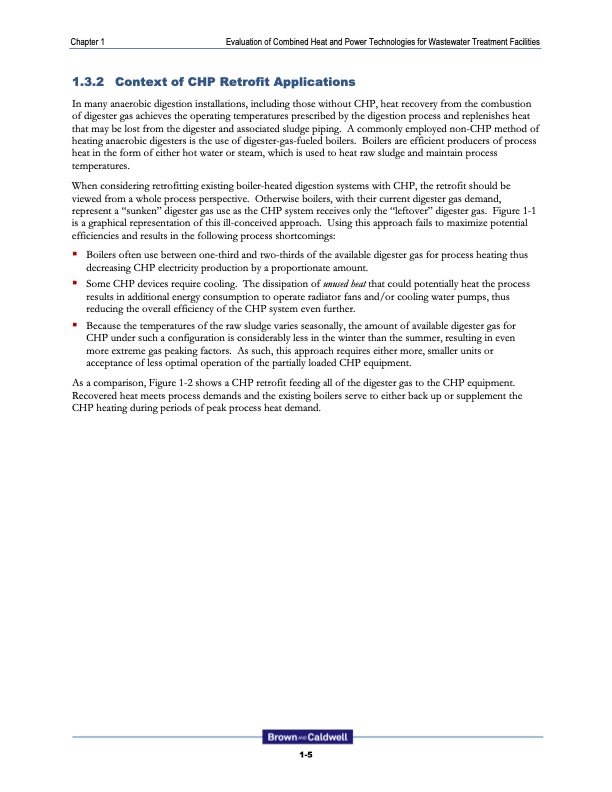
PDF Publication Title:
Text from PDF Page: 020
Chapter 1 Evaluation of Combined Heat and Power Technologies for Wastewater Treatment Facilities 1.3.2 ContextofCHPRetrofitApplications In many anaerobic digestion installations, including those without CHP, heat recovery from the combustion of digester gas achieves the operating temperatures prescribed by the digestion process and replenishes heat that may be lost from the digester and associated sludge piping. A commonly employed non-CHP method of heating anaerobic digesters is the use of digester-gas-fueled boilers. Boilers are efficient producers of process heat in the form of either hot water or steam, which is used to heat raw sludge and maintain process temperatures. When considering retrofitting existing boiler-heated digestion systems with CHP, the retrofit should be viewed from a whole process perspective. Otherwise boilers, with their current digester gas demand, represent a “sunken” digester gas use as the CHP system receives only the “leftover” digester gas. Figure 1-1 is a graphical representation of this ill-conceived approach. Using this approach fails to maximize potential efficiencies and results in the following process shortcomings: Boilers often use between one-third and two-thirds of the available digester gas for process heating thus decreasing CHP electricity production by a proportionate amount. Some CHP devices require cooling. The dissipation of unused heat that could potentially heat the process results in additional energy consumption to operate radiator fans and/or cooling water pumps, thus reducing the overall efficiency of the CHP system even further. Because the temperatures of the raw sludge varies seasonally, the amount of available digester gas for CHP under such a configuration is considerably less in the winter than the summer, resulting in even more extreme gas peaking factors. As such, this approach requires either more, smaller units or acceptance of less optimal operation of the partially loaded CHP equipment. As a comparison, Figure 1-2 shows a CHP retrofit feeding all of the digester gas to the CHP equipment. Recovered heat meets process demands and the existing boilers serve to either back up or supplement the CHP heating during periods of peak process heat demand. 1-5PDF Image | Combined Heat and Power Technologies for Wastewater Facilities

PDF Search Title:
Combined Heat and Power Technologies for Wastewater FacilitiesOriginal File Name Searched:
300_CHP-EPA-w-Apps.pdfDIY PDF Search: Google It | Yahoo | Bing
Capstone Turbine and Microturbine: Capstone microturbines used and new surplus for sale listing More Info
Consulting and Strategy Services: Need help with Capstone Turbine, sizing systems, applications, or renewable energy strategy, we are here to assist More Info
Container Lumber Dry Kiln: Since 1991 developing and innovating dry kilns using standard shipping containers More Info
Supercritical CO2 Lumber Dry Kiln: Compact fast drying in 3 days or less for small amounts of wood and lumber drying More Info
BitCoin Mining: Bitcoin Mining and Cryptocurrency... More Info
Publications: Capstone Turbine publications for microturbine and distributed energy More Info
FileMaker Software for Renewable Energy Developing database software for the renewable energy industry More Info
CO2 Gas to Liquids On-Demand Production Cart Developing a supercritical CO2 to alcohol on-demand production system (via Nafion reverse fuel cell) More Info
Stranded Gas for low cost power Bitcoin Mining Using stranded gas for generators may provide breakthrough low power costs for cryptocurrency miners. More Info
| CONTACT TEL: 608-238-6001 Email: greg@globalmicroturbine.com | RSS | AMP |